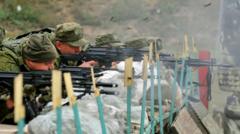### Summary: In 2024, Russia experienced its highest military losses in Ukraine, with an estimated 45,287 confirmed deaths. Factors are examined, including the escalating recruitment rates, the heavy toll during intense battles, and significant challenges regarding casualty reporting and acknowledgment.
### Title: Staggering Toll: A Deep Dive into Russian Military Losses in Ukraine

### Title: Staggering Toll: A Deep Dive into Russian Military Losses in Ukraine
### Description: An analysis of the grim reality of Russian casualties in the ongoing conflict in Ukraine highlights unprecedented losses and evolving recruitment strategies.
The full-scale war in Ukraine has taken a catastrophic toll on Russian military forces, with the year 2024 marking a record loss of at least 45,287 soldiers. This figure surpasses the combined losses from the previous two years and highlights a significant shift in the dynamics of the conflict. Analyzing open-source data, including military memorials and obituaries, the BBC Russian Service, along with independent media outlet Mediazona, has tirelessly worked to track the fatalities, identifying 106,745 soldiers lost since the conflict escalated.
Military analysts estimate that the actual death toll may be significantly higher; experts suggest the BBC’s numbers might represent only 45% to 65% of the real fatalities, leading to grim estimates ranging from 164,223 to 237,211. Notably, the deadliest day of 2024 was recorded on February 20, where 201 soldiers perished in a Ukrainian strike while attending a medal ceremony—a poignant reminder of the human cost of the war.
Initially, Russian losses manifested in waves correlated with battles for key territories. However, 2024 saw a consistent rise in casualties, averaging about 27 military deaths for every square kilometer gained. Major offensives, particularly around Avdiivka and Bakhmut, led to staggering casualty rates, with a remarkable increase surrounding an assault on Ukrainian territory in August that resulted in 1,226 deaths within a short span.
Analysts like Michael Kofman highlight the futility of tactics employed on the battlefield, which emphasized incessant, costly attacks with minimal advancement relative to losses incurred. The Institute for the Study of War underscores that despite seizing 4,168 square kilometers over the year, the overwhelming casualties suggest inefficacy in military strategy and morale.
Meanwhile, recruitment policies are evolving in response to losses, with heightened incentives for new recruits leading to a surge in volunteer soldiers, including those seeking to evade legal consequences. This change has resulted in a concerning trend where these volunteers, often with little training, become a significant portion of battlefield casualties, making up about a quarter of reported deaths.
Rural areas such as Bashkortostan have borne the brunt of these losses, with compensation offers significantly outpacing average local incomes—encouraging potential recruits despite the risks. The full scope of Russian military losses remains challenging to ascertain due to ongoing conflicts and the recovery of deceased soldiers on active battlefields.
As the war continues, ongoing efforts to collate and validate data on military fatalities will be critical in comprehensively understanding the trajectory of the conflict and its profound human cost.





















